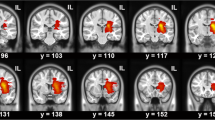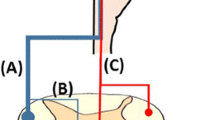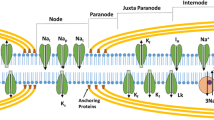Abstract
The cerebellum has a vital role in fine motor control of the limbs. Consequently, downstream changes in peripheral axonal function may develop following a cerebellar infarct, in part, to adapt to the resultant impairment. The present study investigated changes in excitability in ipsilateral and contralateral upper limb peripheral motor axons in patients with acute cerebellar infarct to determine whether plastic changes may have functional relevance. Peripheral nerve excitability studies and detailed clinical assessments of functional impairment were undertaken in 13 patients with acute unilateral cerebellar infarct within 1 week of ictus. Changes were followed longitudinally over 1 year at 3, 6 and 12 months with results compared to 15 age-matched control subjects. Immediately following stroke, there were significant alterations in peripheral nerve excitability parameters in the upper limbs of patients compared to controls that were most evident in the more severely impaired group. There were significant correlations between excitability indices and functional scores in the entire cohort that demonstrated greater changes in axonal function associated with more impairment. Peripheral excitability trended towards normal over the study period in the context of clinical improvement. Following an acute cerebellar infarct, changes were observed in peripheral motor axons bilaterally that were more pronounced in patients with severe functional impairment. The peripheral changes may represent a functionally relevant plastic process reflecting altered activity to adapt to the disability of the stroke.



Similar content being viewed by others
References
Sultan F et al. Unravelling cerebellar pathways with high temporal precision targeting motor and extensive sensory and parietal networks. Nat Commun. 2012;3:924.
Haines DE, Dietrichs E. The cerebellum—structure and connections. Handb Clin Neurol. 2012;103:3–36.
McLeod JG. H reflex studies in patients with cerebellar disorders. J Neurol Neurosurg Psychiatry. 1969;32(1):21–7.
Chen XY, Wolpaw JR. Ablation of cerebellar nuclei prevents H-reflex down-conditioning in rats. Learn Mem. 2005;12(3):248–54.
Wolpaw JR, Chen XY. The cerebellum in maintenance of a motor skill: a hierarchy of brain and spinal cord plasticity underlies H-reflex conditioning. Learn Mem. 2006;13(2):208–15.
Huynh W et al. Longitudinal plasticity across the neural axis in acute stroke. Neurorehabil Neural Repair. 2013;27(3):219–29.
Jankelowitz SK, Howells J, Burke D. Plasticity of inwardly rectifying conductances following a corticospinal lesion in human subjects. J Physiol. 2007;581(Pt 3):927–40.
Adams Jr HP et al. Classification of subtype of acute ischemic stroke. Definitions for use in a multicenter clinical trial. TOAST. Trial of Org 10172 in Acute Stroke Treatment. Stroke. 1993;24(1):35–41.
Definition and diagnosis of diabetes mellitus and intermediate hyperglycaemia, W.H.O.a.I.D. Federation, Editor. 2006: Geneva, Switzerland.
Cicinelli P et al. Interhemispheric asymmetries of motor cortex excitability in the postacute stroke stage: a paired-pulse transcranial magnetic stimulation study. Stroke. 2003;34(11):2653–8.
Butefisch CM et al. Remote changes in cortical excitability after stroke. Brain. 2003;126(Pt 2):470–81.
Jørgensen HS et al. Outcome and time course of recovery in stroke. Part I: outcome. The Copenhagen stroke study. Arch Phys Med Rehabil. 1995;76(5):399–405.
Kim BR et al. Usefulness of the Scale for the Assessment and Rating of Ataxia (SARA) in ataxic stroke patients. Ann Rehabil Med. 2011;35(6):772–80.
Kiernan MC et al. Multiple measures of axonal excitability: a new approach in clinical testing. Muscle Nerve. 2000;23(3):399–409.
Krishnan AV et al. Axonal ion channels from bench to bedside: a translational neuroscience perspective. Prog Neurobiol. 2009;89(3):288–313.
Krishnan AV, Lin CS, Kiernan MC. Nerve excitability properties in lower-limb motor axons: evidence for a length-dependent gradient. Muscle Nerve. 2004;29(5):645–55.
Weiss G. Sur la possibilité de rendre comparables entre eux les appareils servant l’excitation électrique. Arch Ital Biol. 1901;35:413–46.
Burke D, Kiernan MC, Bostock H. Excitability of human axons. Clin Neurophysiol. 2001;112(9):1575–85.
Bostock H, Cikurel K, Burke D. Threshold tracking techniques in the study of human peripheral nerve. Muscle Nerve. 1998;21(2):137–58.
Kiernan MC, Bostock H. Effects of membrane polarization and ischaemia on the excitability properties of human motor axons. Brain. 2000;123(Pt 12):2542–51.
Vagg R et al. Activity-dependent hyperpolarization of human motor axons produced by natural activity. J Physiol. 1998;507(Pt 3):919–25.
Vucic S, Krishnan AV, Kiernan MC. Fatigue and activity dependent changes in axonal excitability in ALS. J Neurol Neurosurg Psychiatry. 2007;78:1202–8.
Huynh W et al. Botulinum toxin modulates cortical maladaptation in post-stroke spasticity. Muscle Nerve. 2013;48(1):93–9.
Kiernan MC et al. Amyotrophic lateral sclerosis. Lancet. 2011;377(9769):942–55.
Huynh W et al. Motor cortex excitability in acute cerebellar infarct. Cerebellum. 2013;12(6):826–34.
Tomlinson S et al. In vivo assessment of HCN channel current (I(h)) in human motor axons. Muscle Nerve. 2010;41(2):247–56.
Berciano J, Garcia A, Infante J. Peripheral nerve involvement in hereditary cerebellar and multisystem degenerative disorders. Handb Clin Neurol. 2013;115:907–32.
Tomlinson SE et al. Nerve excitability studies characterize Kv1.1 fast potassium channel dysfunction in patients with episodic ataxia type 1. Brain. 2010;133(Pt 12):3530–40.
Koch G. Repetitive transcranial magnetic stimulation: a tool for human cerebellar plasticity. Funct Neurol. 2010;25(3):159–63.
Acknowledgments
WH was awarded a postgraduate scholarship from the National Health & Medical Research Council of Australia (NHMRC). AK was supported by an NHMRC Career Development Award (grant 568680). MK was supported by funding to Forefront from the National Health and Medical research Council of Australia Program Grant (#1037746)
Conflict of Interest
The authors have no conflicts of interest.
Financial Disclosure
W.H. is receiving the NHMRC postgraduate medical scholarship.
Author information
Authors and Affiliations
Corresponding author
Rights and permissions
About this article
Cite this article
Huynh, W., Lin, C.SY., Krishnan, A.V. et al. Transynaptic Changes Evident in Peripheral Axonal Function After Acute Cerebellar Infarct. Cerebellum 13, 669–676 (2014). https://doi.org/10.1007/s12311-014-0577-0
Published:
Issue Date:
DOI: https://doi.org/10.1007/s12311-014-0577-0




